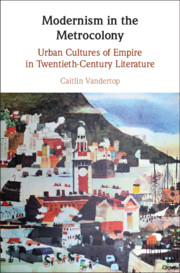Book contents
- Modernism in the Metrocolony
- Modernism in the Metrocolony
- Copyright page
- Contents
- Acknowledgements
- Introduction The Colonies in Concrete
- Chapter 1 Metrocolonial Modernism
- Chapter 2 Architectures of Free Trade in Conrad’s Singapore
- Chapter 3 Synchronising Empire Time in Joyce’s Dublin
- Chapter 4 Anglo-Indian Crises of Development
- Chapter 5 Ecologies of Empire in Oceanian Modernism
- Conclusion Mega-Dublins
- Notes
- Bibliography
- Index
Chapter 5 - Ecologies of Empire in Oceanian Modernism
Published online by Cambridge University Press: 05 November 2020
- Modernism in the Metrocolony
- Modernism in the Metrocolony
- Copyright page
- Contents
- Acknowledgements
- Introduction The Colonies in Concrete
- Chapter 1 Metrocolonial Modernism
- Chapter 2 Architectures of Free Trade in Conrad’s Singapore
- Chapter 3 Synchronising Empire Time in Joyce’s Dublin
- Chapter 4 Anglo-Indian Crises of Development
- Chapter 5 Ecologies of Empire in Oceanian Modernism
- Conclusion Mega-Dublins
- Notes
- Bibliography
- Index
Summary
This chapter considers post-independence writing from the urban South Pacific, focusing on the capital of Fiji, Suva, and its association with the birth of Oceanian modernism in the 1970s. Elaborating first on the ‘swamp to city’ narrative surrounding the construction of the capital on reclaimed land, it examines the amphibious themes that appear in narratives of gendered walking by writers including the Fijian environmental activist Vanessa Griffen and Indo-Fijian writer Subramani, alongside fiction and essays by the Fijian/Tongan writer Epeli Hau‘ofa. Drawing on the critical framework structuring previous chapters, the chapter shows how each of these writers interrogates colonial narratives in the Pacific port city by linking the reappearance of its terraqueous past to issues of ecological precarity and the colonial legacies that have exacerbated them.
- Type
- Chapter
- Information
- Modernism in the MetrocolonyUrban Cultures of Empire in Twentieth-Century Literature, pp. 120 - 145Publisher: Cambridge University PressPrint publication year: 2020

